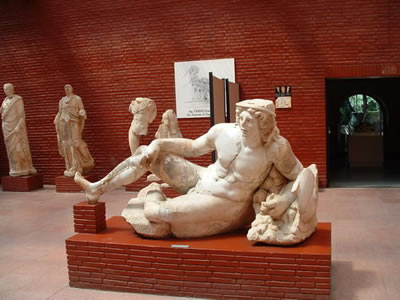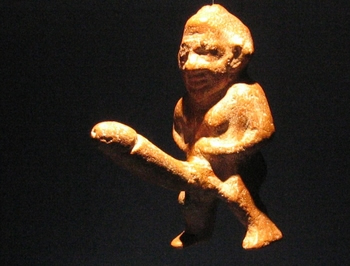
Classic Turkey trip, 2012
EPHESUS
Church of St. John; Roman City- Library; Theater&Cliff Houses
HOME :
turkey trip Istanbul I Istanbul II Istanbul III Istanbul IV Bursa Troy Pergamum Sardes - Pamukkale Aphrodisia Ephesus Priene Didyma MiletCapitels
Basilica of St. John - Ephesus Museum Library of Celsus and City Ruins - Terrace Houses
Ephesus, located in what is now known as Selçuk, has had a long and glorious history. It was one of of the twelve cities of the Ionian League during the Classical Greek era. At that time it became famous for the Temple of Artemis (completed around 550 BC), one of the Seven Wonders of the Ancient World. In the 1st century BCE under Roman rule its population grew to over 250,000. Under Emperor Constantine the city was rebuilt and new public baths were erected. Ephesus was a rich city, as is attested even today by the "terrace houses" which contain many beautiful mosaics and frescos that are currently being excavated and restored.
Later it became famous as one of the seven churches of Asia that are cited in the Book of Revelation; the gospel of John may have been written here, it was the site of the council of Ephesus in the 5th century CE. The virgin Mary may have spent her final years here and may be buried here. Or not. The town was partially destroyed by an earthquake in 614 AD. The city's importance as a commercial center declined as the harbor was slowly silted up by the Cayster River
|
 |
 |
|
| The basilica of St. John was built in the 6th century, all that is left today is a very large complex of ruins, as can be seen above and below. Allegedly it was built over the grave of the apostle John, who may or may not have been the one who (a) wrote the gospel of John and/or (b) brought Mary to Ephesus where she allegedly lived in her final years in a house which we did not visit. | |||
 |
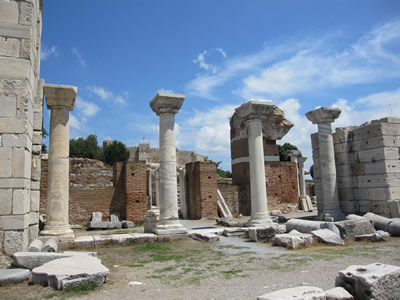 |
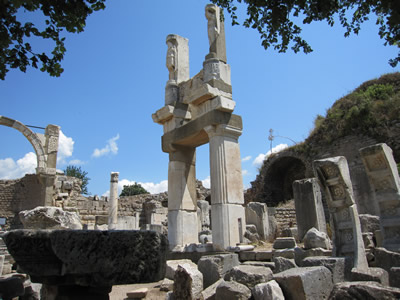 |
|
| Ephesus Museum | After our visit to the Basilica of St. John we explored the Museum in Ephesus which is rather small but contains many very interesting items found in the ruins of the Artemis temple and other sites in the area, |
||
Artemis Statue |
Statue of a young warrior |
Another version of a Statue of Artemis - there are a number of explanations offered for the rather interesting decorations on the cult statues dress. Pineapples? Gourds? Eggs? Your guess is probably almost as good as mine, but let's not forget that the Artemis Cult is dedicated to a fertility goddess |
|
|
Priapus Statue |
|||
| Library of Celsus | |||
 |
The library of Celsus was built in 135 CE to store 12,000 scrolls, making it one of the great libraries of antiquity. A terrible fire destroyed the interior of the library and its collection in 262 CE, the iconic facade is a reconstruction of the 1960s. serve as a monumental tomb for Celsus. Celsus is buried in a sarcophagus beneath the library, an usual honor | 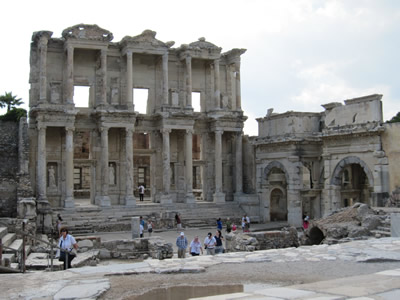 |
|
| |
|||
 |
On the left the Kuretenstreet, the road leading to the library. In this picture it is only moderately crowded, later the tour from a cruise ship came and the entire street was filled with people. Considering the size of the population during Roman times, that's probably how it really was. Except that when we were there the only animals in sight were the cats that one finds everywhere in turkey. |
|
||
 |
 |
 |
||
 |
Above the arch of the temple of Hadrian - an example of the emperor cult that was common in Rome. To the right the theater in Ephesus. I skipped that part - the rains were coming down and I headed for cover. But Birgit valiantly took another picture. On the left Kuretenstreet near the terrace houses. |  |
||
| The terrace houses are a an important, fairly recent excavation in Ehesus. We felt quite privileged that we were given a tour by one of the archeologists who is actually involved in the excavation and the current restoration of the houses. The picture in the middle show Italian experts working on restoring the frescos that are decorating the rooms. On the right is a glimpse of one of the beautiful mosaics that are typical of the rooms of the houses. |  |
 |
||
| Below pictures of the beautiful frescos that were hidden for almost two thousand years under the rubble that covered the terrace houses. | ||||
 |
 |
 |
|
|


